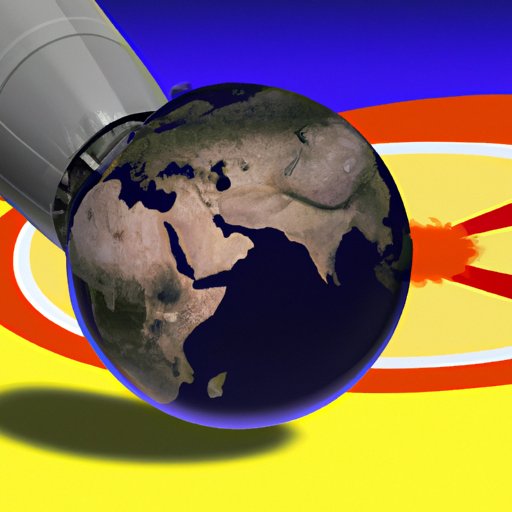Introduction
Nuclear weapons are some of the most powerful and destructive forces known to man, capable of wreaking havoc on an unprecedented scale. In recent years, the development and stockpiling of nuclear weapons has become a major concern for global security, as countries around the world strive to acquire the most powerful nuclear arsenals. But what is the biggest nuke in the world? This article will explore the history and power of the world’s largest nuclear weapons, and examine their impact on global security.
A Comprehensive Guide to the World’s Largest Nuclear Weapons
Exploring the power of the biggest nuclear weapons can help us to gain a better understanding of the risks posed by nuclear proliferation. To begin, let’s take a look at the history and development of the world’s largest nukes.
History of the Biggest Nukes
The first nuclear weapon was developed by the United States during the Second World War, when the atomic bomb known as “Little Boy” was dropped on the Japanese city of Hiroshima in 1945. This marked the beginning of the nuclear age, and since then nuclear weapons have become increasingly powerful and sophisticated.
In the decades that followed, the Soviet Union and United States engaged in an intense nuclear arms race, with both countries striving to develop bigger and more powerful nuclear weapons. The Soviet Union was the first to develop a hydrogen bomb in 1953, which was hundreds of times more powerful than the atomic bombs used in World War II. Since then, other countries such as France, China, India, Pakistan, and North Korea have also developed nuclear weapons.
Exploring the Power of the Biggest Nuclear Weapons
The biggest nuke in the world is the Tsar Bomba, a 50-megaton hydrogen bomb developed by the Soviet Union in 1961. This bomb had the explosive power of 3,800 Hiroshima bombs, and was the most powerful nuclear weapon ever detonated. Other large nuclear weapons include the B41 thermonuclear bomb (25 megatons), the Castle Bravo thermonuclear bomb (15 megatons), and the W88 Trident II warhead (475 kilotons).
An Analysis of Nuclear Arms Race: Who Holds the Most Powerful Nukes?
The size and power of nuclear weapons vary greatly from country to country. Major nuclear powers such as the United States, Russia, and China possess the most powerful and advanced nuclear arsenals, while smaller countries such as North Korea and Pakistan have relatively limited capabilities. Let’s take a closer look at the nuclear arsenals of some of the world’s major nuclear powers.
Major Nuclear Powers and Their Nuclear Arsenals
The United States is one of the most powerful nuclear powers in the world, with an estimated 6,185 warheads in its arsenal. The majority of these warheads are deployed on intercontinental ballistic missiles (ICBMs) or submarine-launched ballistic missiles (SLBMs). The US also possesses a number of tactical nuclear weapons, such as air-launched cruise missiles and gravity bombs.
Russia is the second most powerful nuclear power, with an estimated 7,000 warheads in its arsenal. Like the US, the majority of Russia’s warheads are deployed on ICBMs and SLBMs, but it also possesses a number of tactical nuclear weapons, such as short-range ballistic missiles and air-launched cruise missiles.
China is the third most powerful nuclear power, with an estimated 260 warheads in its arsenal. Unlike the US and Russia, the majority of China’s warheads are deployed on land-based missiles, though it also possesses a small number of sea-launched ballistic missiles and air-launched cruise missiles.
Examining the Technical Specifications of the Largest Nukes
The technical specifications of the world’s largest nuclear weapons vary greatly from country to country. The Tsar Bomba, for example, had a yield of 50 megatons and a range of 13,000 kilometers. By comparison, the B41 thermonuclear bomb had a yield of 25 megatons and a range of 9,000 kilometers, while the Castle Bravo thermonuclear bomb had a yield of 15 megatons and a range of 6,000 kilometers.
What is the Impact of the Biggest Nuclear Weapons on Global Security?
The development and stockpiling of nuclear weapons have had a profound effect on global security, raising concerns about the risk of nuclear proliferation and the potential for nuclear conflict. Let’s take a closer look at the impact of the world’s biggest nukes on global security.
Risk of Nuclear Proliferation
The possession of nuclear weapons by major powers has created a risk of nuclear proliferation, as other countries seek to acquire their own nuclear arsenals. This can lead to an increase in the number of countries with nuclear weapons, which raises the risk of nuclear conflict and makes it harder to control the spread of nuclear technology.
Deterrence of War and Conflict
At the same time, the possession of nuclear weapons by major powers can act as a deterrent to war and conflict. The threat of mutual destruction helps to prevent countries from using nuclear weapons against each other, and thus helps to maintain global peace and stability.
Conclusion
This article has provided a comprehensive guide to the world’s largest nuclear weapons, exploring their history, power, and impact on global security. We have seen that the biggest nuke in the world is the Tsar Bomba, a 50-megaton hydrogen bomb developed by the Soviet Union in 1961. Major nuclear powers such as the United States, Russia, and China possess the most powerful and advanced nuclear arsenals, while the possession of nuclear weapons by major powers has raised concerns about the risk of nuclear proliferation. At the same time, the threat of mutual destruction has acted as a deterrent to war and conflict, helping to maintain global peace and stability.


